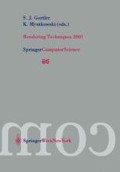Abstract
We present a new technique for exactly computing glossy reflections and transmissions of polygonal Lambertian luminaires with linearly-varying radiant exitance. To derive the underlying closed-form expressions, we introduce a rational generalization of irradiance tensors and an associated recurrence relation. The generalized tensors allow us to integrate a useful class of rational polynomials over regions of the sphere; this class of rational polynomials can simultaneously account for the linear variation of radiant exitance across a planar luminaire and simple forms of non-Lamberti an scattering. Applications include the computation of irradiance at a point, view-dependent reflections from glossy surfaces, and transmissions through glossy surfaces, where the scattering is limited to Phong distributions and the incident illumination is due to linearly-varying luminaires. In polyhedral environments, the resulting expressions can be exactly evaluated in quadratic time (in the Phong exponent) using dynamic programming or efficiently approximated in linear time using standard numerical quadrature. To illustrate the use of generalized irradiance tensors, we present a greatly simplified derivation of a previously published closed-form expression for the irradiance due to linearly-varying luminaires, and simulate Phong-like scattering effects from such emitters. The validity of our algorithm is demonstrated by comparison with Monte Carlo.
Access this chapter
Tax calculation will be finalised at checkout
Purchases are for personal use only
Preview
Unable to display preview. Download preview PDF.
References
James Arvo. Analytic Methods for Simulated Light Transport. PhD thesis, Yale University, December 1995.
James Arvo. Applications of irradiance tensors to the simulation of non-Lambertian phenomena. In Computer Graphics Proceedings, Annual Conference Series, ACM SIGGRAPH, pages 335–342, August 1995.
Daniel R. Baum, Holly E. Rushmeier, and James M. Winget. Improving radiosity solutions through the use of analytically determined form-factors. Computer Graphics, 23(3):325–334, July 1989.
Marcel Berger. Geometry, volume 2. Springer-Verlag, New York, 1987. Translated by M. Cole and S. Levy.
Min Chen. Mathematical Methods for Image Synthesis. PhD thesis, California Institute of Technology, June 2001. http://www.cs.caltech.edu/çchen/papers/thesis/phd_thesis.ps.gz.
Min Chen and James Arvo. A closed-form solution for the irradiance due to linearly-varying luminaires. In B. Péroche and H. Rushmeier, editors, Rendering Techniques 2000. Springer-Verlag, New York, 2000.
Thomas H. Cormen, Charles E. Leiserson, and Ronald L. Rivest. Introduction to Algorithms. McGraw-Hill, New York, 1990.
David L. DiLaura. Non-diffuse radiative transfer 3: Inhomogeneous planar area sources and point receivers. Journal of the Illuminating Engineering Society, 26(1), 1997.
Nicholas Holzschuch and Franccois X. Sillion. Accurate computation of the radiosity gradient for constant and linear emitters. In Proceedings of the Sixth Eurographics Workshop on Rendering, Dublin, Eire, June 1995.
John R. Howell. A Catalog of Radiation Configuration Factors. McGraw-Hili, New York, 1982.
Leonard Lewin. Dilogarithms and associated functions. Macdonald, London, 1958.
Bui Tuong Phong. Illumination for computer generated pictures. Communications of the ACM, 18(6):311–317, June 1975.
Mark C. Reichert. A two-pass radiosity method driven by lights and viewer position. Master’s thesis, Cornell University, January 1992.
M. Schreiber. Differential Forms: A Heuristic Introduction. Springer-Verlag, New York, 1984.
Peter Schroder and Pat Hanrahan. On the form. factor between two polygons. In Computer Graphics Proceedings, Annual Conference Series, ACM SIGGRAPH, pages 163–164, August 1993.
Michael Spivak. Calculus on Manifolds. Benjamin/Cummings, Reading, Massachusetts, 1965.
Michael M. Stark and Richard F. Riesenfeld. Exact illumination in polygonal environments using vertex tracing. In B. Péroche and H. Rushmeier. editors, Rendering Techniques 2000. Springer-Verlag, New York, 2000.
Author information
Authors and Affiliations
Editor information
Editors and Affiliations
Rights and permissions
Copyright information
© 2001 Springer-Verlag Wien
About this paper
Cite this paper
Chen, M., Arvo, J. (2001). Simulating Non-Lambertian Phenomena Involving Linearly-Varying Luminaires. In: Gortler, S.J., Myszkowski, K. (eds) Rendering Techniques 2001. EGSR 2001. Eurographics. Springer, Vienna. https://doi.org/10.1007/978-3-7091-6242-2_3
Download citation
DOI: https://doi.org/10.1007/978-3-7091-6242-2_3
Published:
Publisher Name: Springer, Vienna
Print ISBN: 978-3-211-83709-2
Online ISBN: 978-3-7091-6242-2
eBook Packages: Springer Book Archive

